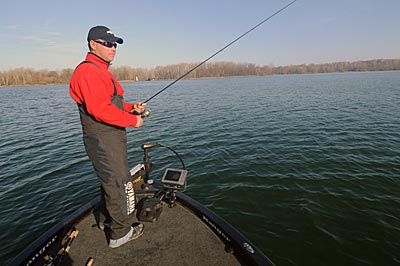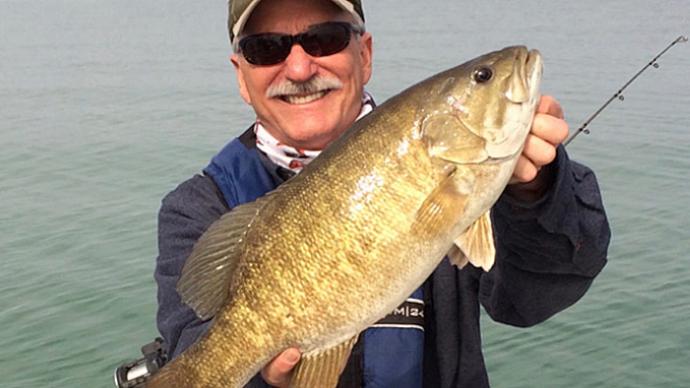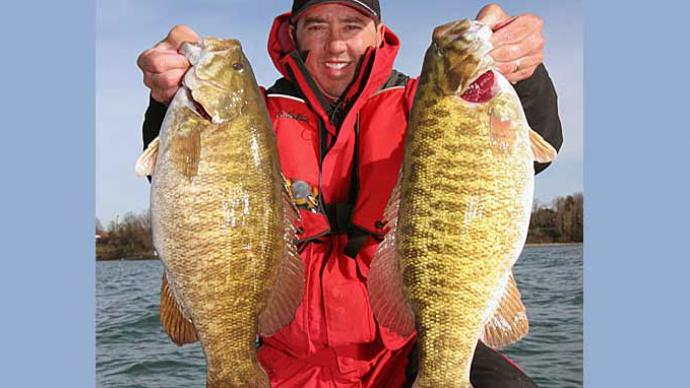
Tournaments have proven Lake Erie is a smallmouth bass factory.
During the major tournaments on Erie, the top contenders consistently catch limits of brown bass in the 18- to 20-pound range. Major League Fishing (MLF) pro Dave Lefebre believes the numbers and size of the smallmouth in Lake Erie make it such a fantastic smallmouth fishery. He notes the lake is a “perfect match” for smallmouth because it contains lots of rocks, deep water, and all kinds of bait, including little perch, trout fry, gobies, crawfish, shad, smelt, and emerald shiners.
The entire lake produces excellent smallmouth fishing, but Lefebre favors his home water section of Presque Isle Bay in Erie, Pa. "I like this area because, on a giant scale, it is like a staging area,” Lefebre says. “It is the middle of the lake, and we are about 100 miles from the flat end of the lake.” He describes this lake section as a pinch point because it is the narrowest part of Erie and contains more current and deeper water than other areas.
Lefebre usually starts catching some smallmouth in February. Still, he suggests the end of March is when prespawn bass stage in the 25- to 30-foot range in preparation for moving into Presque Isle Bay. The fish funneled into the bay about the first or second week of April. Lefebre’s favorite lure for staging prespawn bass is a Steel Shad blade bait in gold for dirty water or silver for clear water. He will also catch some fish on a drop-shot rig with minnow-type soft plastics.
The smallmouth move into the bay, where the fish spawn along sand flats. “They move pretty fast into that 14- to 15-foot range and hang out for maybe a week or two,” Lefebre says. He claims there will be smallmouth in prespawn, spawn, and postspawn stages hanging out in the bay for about two months.
The Pennsylvania pro tempts prespawn smallmouth in the bay with crankbaits, jerkbaits, and tube baits. He favors Rapala DT-10 and DT-14 crankbaits in Helsinki Shad and Caribbean Shad hues. A Rapala Shadow Rap in shad hues is Lefebre’s favorite jerkbait for prespawn smallmouth. Still, he will also throw a Rapala Ripstop when he notices smallmouth are feeding on emerald shiners.
Snapping a tube bait on a 1/4-ounce jighead off the bottom is another effective tactic Lefebre employs for prespawn smallmouth. He opts for green pumpkin tubes on cloudy days and watermelon with metal flake tubes in sunny weather.

Smallmouth in the bay spawn at depths from 2 to 8 feet deep, where Lefebre can catch bedding fish on a flipping tube with 20-pound test line and a flipping stick. “It’s hard to beat a drop shot (with a goby-imitating bait) though because a Goby is a bed invader,” Lefebre says. Lefebre likes to twitch a weightless white, chartreuse, or bubblegum Yamamoto D Shad soft plastic jerkbait on a 4/0 hook along the spawning flats when he cannot see bedding fish. “They will come up off the beds and just smoke it,” Lefebre says.
The MLF competitor continues to throw the D Shad around bass fry during the postspawn. He also likes throwing topwater walking baits like the Rapala Skitter Walk or a topwater popper like the Storm Lures Arashi Pop. “They will bite topwaters like crazy in the postspawn,” Lefebre says. “It’s just trying to figure out which one they want, either the walking one or the slower pop and pause and that feather tail in their face.”
Most smallmouth leave the bay in the summertime and move out to depths of 40 to 50 feet, where they hang out with walleyes feeding on suspended baitfish. “They get out deep pretty fast,” Lefebre says. He catches summertime smallmouth mainly on drop-shot rigs with minnow baits or the D Shad. Lefebre scales down to shad-shaped finesse worms if the fish ignore these larger baits. He usually starts with white or shad colors first and then switches to darker goby colors if the fish ignore his initial offerings.
Lefebre covers a lot of water in the summer, looking for ridges, veins, and isolated boulders near break lines. “Those solo rocks are just the best,” he says.
When fall arrives, Lefebre says the fish start chewing again and move up shallow to 20 to 25 feet deep and eventually into the 10- to 12-foot range. “That is another time when cranking a DT-10 on the main lake is good,” he says. Lefebre also recommends using a drop-shot rig and a Ned Rig for fall smallmouth in the shallows.
During late October and throughout November, Lefebre finds smallmouth in the 25- to 35-foot range as the water temperature drops below 50 degrees. He notes this is the only time of the year smallmouth stack up on structures such as steep breaks and points. The Steel Shad blade bait becomes his top choice for catching late fall and early winter smallmouth.
BassResource may receive a portion of revenues if you make a purchase using a link above.




